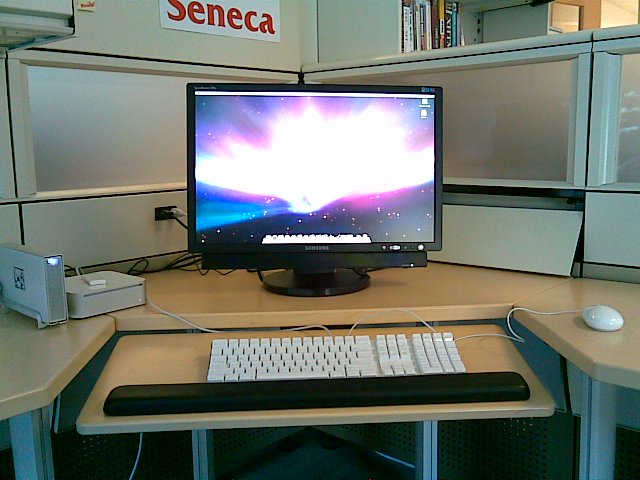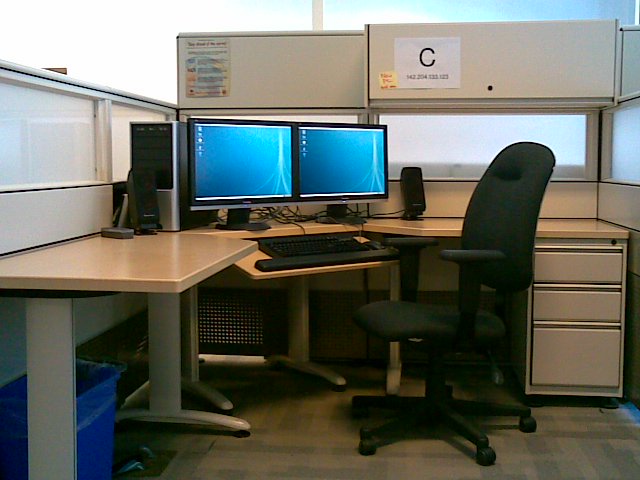CDOT Development Systems
These machines are in the CDOT area on the first floor of the TEL building.
Contents
Ground Rules
- Take responsibility for your actions.
- Don't blow up other people's stuff.
- Expect other people to blow up your stuff.
- Don't turn these machines off.
- Before rebooting, check with the other logged-in users, and check on #seneca on IRC.
- Work under your own account, using root as sparingly as possible. If you need additional accounts, create them, but put your name in the comment (GCOS) field.
- Don't create public services.
- These machines are never backed up. Backup your own stuff, frequently.
Disk Space
Keep an eye on disk space -- both your own usage and the free space on the machine. Delete stuff you don't need (especially temp files and build debris).
Most of the CDOT machines have unassigned storage within their volume group. If you need additional space in a filesystem and know how to use LVM safely, feel free to allocate additional space as needed, but do not assign more space than required for your work (it's easier to add space to a filesystem than to remove it to add it to another filesystem). If you do not know how to administer LVM safely, ask an experienced user to add space to the filesystem for you -- it's very easy to destroy a filesystem. Please experiment with and learn about LVM on your own systems or in a virtual machine.
Virtual Machines
Please feel free to configure KVM virtual machines on the PCs. Because virtualization technologies conflict, please discuss the use of other hypervisors before deploying them.
When using virtual machines, please:
- Use a logical volume (LV) for the VM image
- Shutdown the VM when not in use
Connectivity Status
The connectivity of the systems is tested every 5 minutes using ICMP echo (ping) and may be viewed on the CDOT Development System Status page.
Machine names, IPs, and Status
Please update this information as you work on the machines' configuration.
To encourage less breakage, please put some information about what you are doing on a machine. A sample machine pages is located at CDOT_Development_Systems/ExampleSystem
| Hostname | Type | Location | IP | Status | Notes |
|---|---|---|---|---|---|
| germany | PC - Quad Core, 8GB, 1TB | T1045 | 142.204.133.102 | Fedora 10 x86_64 installed |
|
| hongkong | PC - Quad Core, 8GB, 1TB | T1037 | 142.204.133.30 | Fedora 10 x86_64 installed |
|
| india | PC - Quad Core, 8GB, 1TB | T1045B | 142.204.133.28 | Fedora 10 x86_64 installed |
|
| australia | PC - Quad Core, 8GB, 1TB | T1045B | 142.204.133.24 | Fedora 10 x86_64 installed with kvm, devtools, etc. |
Will be running a local build bot |
| canada | iMac | 1045A | 142.204.133.7 | OS X 10.5.6 | Xcode + macports + mozilla build requirements |
| russia | iMac | T1045 | 142.204.133.101 | Broken | Somebody broke this machine's software |
| easterisland(to be set) | Mac mini | T1045H - cubicle E | 142.204.133.121 | Mozilla build environment installed: Xcode, MacPorts, Mercurial, Autoconf, libidl |
|
| spain | Mac mini | T1045E - cubicle A | 142.204.133.122 | Mozilla build environment installed: Xcode, MacPorts, Mercurial, Autoconf, libidl |
|
| china | PC | T1045E - cubicle B | 142.204.133.36 | F8 with four F9 VMs (func1-func4) | |
| liberia | PC | T1045E - cubicle C | 142.204.133.123 | F8 | Note: This machine is being actively used for mdrk/dxr development. |
| newzealand | PC | T1045E - cubicle D | 142.204.133.124 | XP (with ethernet drivers installed) | |
| ireland | PC | T1045B | 142.204.133.26 | F9 | |
| scotland | PC -Quad core, 8 GB DDR3, 6*1.5T | T1045A | 142.204.133.22 | F10 |
Tip:
These hostnames have all been added to the cdot.proximity.on.ca domain for convenience. If you add that domain to your search domains in your DNS configuration, you can refer to the CDOT hosts by name. If you are using Linux or Mac OSX, you can add a search domain in your /etc/resolv.conf file by editing the search line:
search whatever.was.already.here.com cdot.proximity.on.ca
Alternately, you can append the machine names and IPs to the hosts file (/etc/hosts on Linux and Mac OSX, c:\windows\system32\drivers\etc\hosts on Windows) -- do not delete the existing contents of that file, just add this text:
# CDOT host file - from http://zenit.senecac.on.ca/wiki/index.php?title=CDOT_Development_Systems - 2009.01.28 version: 142.204.133.7 canada 142.204.133.22 scotland 142.204.133.24 australia 142.204.133.25 russia 142.204.133.26 ireland 142.204.133.28 india 142.204.133.30 hongkong 142.204.133.36 china 142.204.133.121 easterisland 142.204.133.122 spain 142.204.133.123 liberia 142.204.133.124 newzealand
After doing this, you can access the machines by name: ssh userid@liberia
Equipment
- Four PCs - quad-core, 8GB RAM, 1TB disk
- Four PCs - quad-core, 4GB RAM, 500GB disk, dual 22" displays on each
- One PC - quad-core, 8GB RAM, 6*1.5TB disk
- Two Mac Minis - dual-core, 2GB RAM, 120GB disk + external drive, 24" displays
- Two iMacs - dual-core, 4GB RAM, ???GB disk, 20" display
Configuration
- On the 64-bit PCs:
- Install the current version of Fedora as the base OS
- Install virtual machines for:
- Windows Vista
- Windows XP SP3
- Some PCs will have Windows XP/Vista installed as the base OS (for high-performance video access, i.e., Canvas3D)
- Install the toolchain(s) required (e.g., for Mozilla development - Win/Linux/Mac)
PC Partitioning
500GB Drives
Drives are ~500 GB:
- Partition 1: 150 GB NTFS containing XP SP2
- Partition 2: 100 GB NTFS containing Vista
- Partition 3: 100 MB Linux boot partition
- Partition 4: Extended partition
- Partitions 5-9: 50 GB Linux LVM PVs (last one will be smaller)
Linux LVM LV layout:
- 50 GB / filesystem (ext3)
- 80 GB /home filesystem (ext3)
- 50 GB /var filesystem
1TB Drives
Drives are ~1000 GB:
- Partition 1: 200 MB ext3 /boot
- Partition 2: 200 MB ext3 /boot2
- Partition 3: 200GB LVM PV
- Partition 4: Extended partition
- Partitions 5-9: 200GB LVM PV (last one sized as needed)
Linux LVM LV layout:
- 50 GB / filesystem (ext3)
- 50 GB /home filesystem (ext3)
- 50 GB /var filesystem
- 8 GB swap filesystem
Software to be installed
(Remember, other tools can be added later!)
- Build tools required for Mozilla build (Win/Linux/Mac). NOTE: use VS.NET Pro on Win32 vs. Express
- PuTTY on WinXP/Vista
- Current version of FF2 and TB
Mac installed software
- Xcode3.0
- fink - (http://www.finkproject.org/download/srcdist.php)
- download tarball, untar and ./boostrap (prees enter all the time to choose default)
- . /sw/bin/pathsetup.sh
- fink selfupdate-cvs
- fink install orbit orbit-dev
- sudo apt-get glib
Computer setup
Windows setup
- I used CPUID to discover the motherboard
- Install ethernet drivers (Installed PRO2KXP.exe -- Ver:12.4 -- Date:2/24/2008 -- Size:11414 KB)
- http://www.windowsupdate.com until you get all updates
Network setup
* 142.204.133.65 Gateway * 255.255.255.192 Netmask * 142.204.43.43 DNS 1 * 142.204.1.2 DNS2
Security
- Disable remote root/admin login on all operating systems.
Accounts
- Please create an account for yourself and use it for all development work on these machines.
Resources
- Reinstalling GRUB (needed to restore access to Linux when Windows is installed after Linux): http://dailypackage.fedorabook.com/index.php?/archives/161-System-Recovery-Week-Dealing-with-Disk-Images.html

